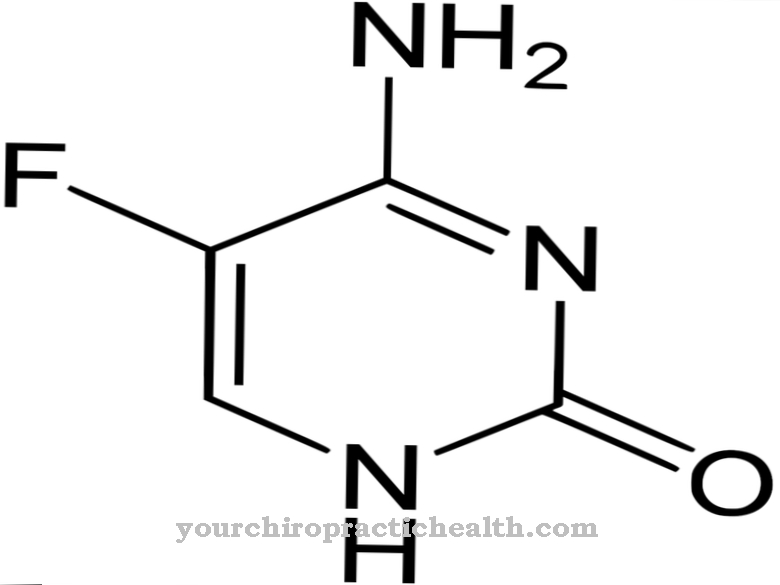With the active ingredient Trimethoprim it is an antibiotic that belongs to the diaminopyrimidine category. The drug is used to treat infections caused by bacteria. The drug trimethoprim is particularly often used to treat bladder infections in female patients. As a rule, the drug is taken in the morning and evening after meals. The average duration of therapy is between three and five days.
What is trimethoprim?

Trimethoprim is an active ingredient from the group of antibiotics and is used in many cases in combination with the substance sulfamethoxazole. The possible undesirable side effects are similar to those that can occur with other types of antibiotics. Symptoms such as nausea and vomiting, fever and diarrhea, and blood count disorders, for example, are very common.
The active ingredient trimethoprim is usually available on the market in the form of tablets and liquid syrup. So-called generics are also sold.
From a chemical point of view, the substance trimethoprim is the substance trimethoxybenzylpyrimidine. It has a molar mass of 290.3 grams per mole. The substance is a white to yellowish powder and shows poor solubility in water.
Pharmacological effect
The drug trimethoprim is primarily characterized by a bacteriostatic effect. Because the substance prevents the so-called dihydrofolate reductase, so that the metabolism of folic acid is impaired in gram-negative and gram-positive bacteria.
If the substance is used alone and not in conjunction with other active ingredients, uncomplicated urinary tract infections or infections of the upper respiratory tract are often the cause.
Basically, the drug trimethoprim affects the dihydrofolate reductase of bacteria. In this process, dihydrofolic acid is converted into tetrahydrofolic acid. Tetrahydrofolic acid plays an important role for the cells of bacteria as a substrate that is necessary for the formation of thymidine and purines. If these special building blocks of the DNA are not available, the growth of the bacterial cells is impaired.
Trimethoprim usually only has minor effects on dihydrofolate reductase in humans. In principle, the spectrum of activity of the substance trimethoprim extends to a large number of gram-positive and gram-negative pathogens. It should be noted, however, that therapy with trimethoprim alone quickly develops resistance to antibiotics.
In the case of oral administration, the substance trimethoprim is absorbed relatively quickly. The active ingredient reaches the highest concentration in the serum about two hours after administration. The half-life is around twelve hours. The drug trimethoprim is metabolized in the liver and then excreted renally. It is therefore important to note that if there is kidney weakness, the drug's metabolites can accumulate.
Medical application & use
The drug trimethoprim is only used relatively rarely as part of a monotherapy. Instead, it is usually used in conjunction with the substance cotrimoxazole as a so-called fixed combination, whereby the active ingredient sulfamethoxazole is used. If trimethoprim is combined with the active ingredient sulfamethoxazole, the possible area of application is also expanded. The substance sulfamethoxazole belongs to the category of sulfonamides.
Treatment of Toxoplasma gondii or Pneumocystis jirovecii is possible in conjunction with trimethoprim. At the same time, however, the spectrum of potential side effects is also expanding.
The combination of the active ingredients trimethoprim and sulfamethoxazole is called cotrimoxazole. This compound is also suitable, for example, for the therapy of the autoimmune disease granulomatosis with polyangiitis.
Pneumocystis pneumonia is a special indication. It is necessary to take co-trimoxazole in high doses over a longer period of time.
In the context of monotherapy, trimethoprim can be administered, for example, in uncomplicated cystitis and to prevent recurring urinary tract infections in children. In principle, monotherapy with the active ingredient trimethoprim is being critically debated.
Risks & side effects
As part of therapy with the drug trimethoprim or combination preparations containing this active ingredient, various undesirable side effects and complaints are possible. These occur with different frequency and vary depending on the individual case.
Trimethoprim is usually a well-tolerated preparation. In some cases, however, gastrointestinal discomfort occurs. Itchy rashes are also possible. In rare cases, the active ingredient inhibits the important human dihydrofolate reductase, which results in a deficiency in tetrahydrofolic acid. This disrupts hematopoiesis, resulting in anemia, thrombopenia, or leukopenia.
In addition, some patients have rashes on the skin, some of which are itchy. Serious skin irritation or Lyell's syndrome are less common. Aseptic meningitis is also possible when taking trimethoprim. Patients sometimes have a fever and blood count disorders appear. Very rarely there are phototoxic reactions and inflammation of the pancreas.
The drug trimethoprim interacts with some substances and should therefore not be taken at the same time. These include, for example, antidiabetic agents, oral contraceptives, diuretics, ciclosporin and indomethacin. Consult a doctor immediately in the event of complaints during therapy.












.jpg)



.jpg)










.jpg)
